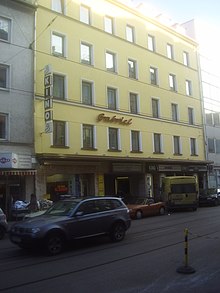Carl Gabriel
Carl Gabriel (born September 24, 1857 in Bernstein in der Neumark , † February 24, 1931 in Munich ) was a German showman and founder of the cinema several times. At the Oktoberfest he made popular attractions such as the witch's swing , the devil's wheel , the steep face and the hippodrome for the first time.
Life
Karl Gabriel , who later called himself Carl , traveled through the country with his father's circus after training as a mechanic and fitter. In 1883 he married in Dresden showmen daughter Margarethe Elisabeth Meisel, who also came from a fairground family. In 1892 he presented his father's wax museum at the Oktoberfest . From the same year they both lived in Munich, where they were granted the right of residence and citizenship in 1896. In 1893 Gabriel and Emil Eduard Hammer opened a wax museum on Neuhauser Strasse in Munich, the Internationale Handelspanoptikum . On July 11, 1896, he organized the first screening of so-called " living pictures " (i.e. film screenings) in Munich. He also ran Panoptika in Düsseldorf and Bochum .
A few years later he also made a name for himself at the Oktoberfest with exotic shows, for example in 1901 with “The Bedouin Camp”, 1909 “The Sudanese Village”, 1910 “Samoa in Munich”, and in 1928 the “Giant People's Show” with 200 people from Africa and China and Japan or 1930 "Die Lippennegerinnen". However, he was also responsible for other Oktoberfest attractions. In 1902, Carl Gabriel opened the hippodrome at the Oktoberfest , which existed as a marquee until 2013. In 1908 he brought the first roller coaster from the USA to Munich. In 1910 he opened the Teufelsrad and in 1930 the first steep face at the Oktoberfest.
Opened movie theaters
But he not only made a contribution to the Oktoberfest, but also to the Munich film scene. After opening a cinema in Berlin in 1905 , one of the city's first movie theaters with the name “The American Bio.- Cie. ” Followed in 1907 on Dachauer Strasse in Munich . ", Which existed until 2019 under the name Gabriel Filmtheater . The Museum Lichtspiele and cinemas in Bochum, Augsburg and Passau followed in 1910 .
In 1913, Carl Gabriel opened Munich's first new film theater, the Sendlinger Tor Lichtspiele . The Heilmann und Littmann company built a cinema palace for him with a gallery, velvet curtain, lighting and hot water heating. It was the first reinforced concrete building in Munich and had 680 rising seats and a screen that was huge for the circumstances at the time. At the opening on October 18, 1913, Gabriel secured the sole screening rights for the 120-minute film “ The Mistress of the Nile ” for 25,000 gold marks ; he invited plenty of celebrities and was celebrated in the press.
Carl Gabriel died in Munich in 1931. He is buried in Munich's Ostfriedhof . On his tombstone he is described as a major show entrepreneur .
Web links
literature
- Florian Dering: What does Carl Gabriel bring to the Oktoberfest? In: The Oktoberfest. One hundred and seventy-five years of Bavarian national frenzy , catalog for the anniversary exhibition in the Munich City Museum July 25 to November 3, 1985, F. Bruckmann, Munich 1985, ISBN 3-7654-2028-X , pp. 366–369.
swell
- ^ A b Anne Dreesbach: Tamed wild: The display of "exotic" people in Germany 1870-1940 , Campus Verlag, 2005, p. 54 f.
- ↑ Dagmar Müller: The oldest cinema in the world Süddeutsche Zeitung, September 2, 2007.
| personal data | |
|---|---|
| SURNAME | Gabriel, Carl |
| BRIEF DESCRIPTION | Showmen and cinema operators |
| DATE OF BIRTH | September 24, 1857 |
| PLACE OF BIRTH | Amber |
| DATE OF DEATH | February 24, 1931 |
| Place of death | Munich |
